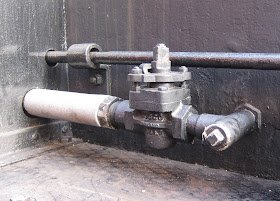This early photo shows the light green layer between cylinders and the end cover.
 |
| June 2011 photo long before putting the pump to work |
The next photo shows the effect of three years' use (and possibly the recent heavy frost?).
 |
| Comprehensive disintegration of the joint material |
In retrospect, what is more to the point is that, while the spec shows the joint material is good for 230 degC and 19bar, the steam supply to the pump has passed through the superheater and is likely to be somewhat hotter than the figure I had originally assumed. I'm thus rather surprised it had lasted as this long!
Later in the restoration process, for all steam joints, I'd switched to a higher spec joint material, namely Klinger's Kingergraphite PSM/AS. More details here.
So that's what will be used for the repair.
I can say I now have more (hard-earned) experience!









